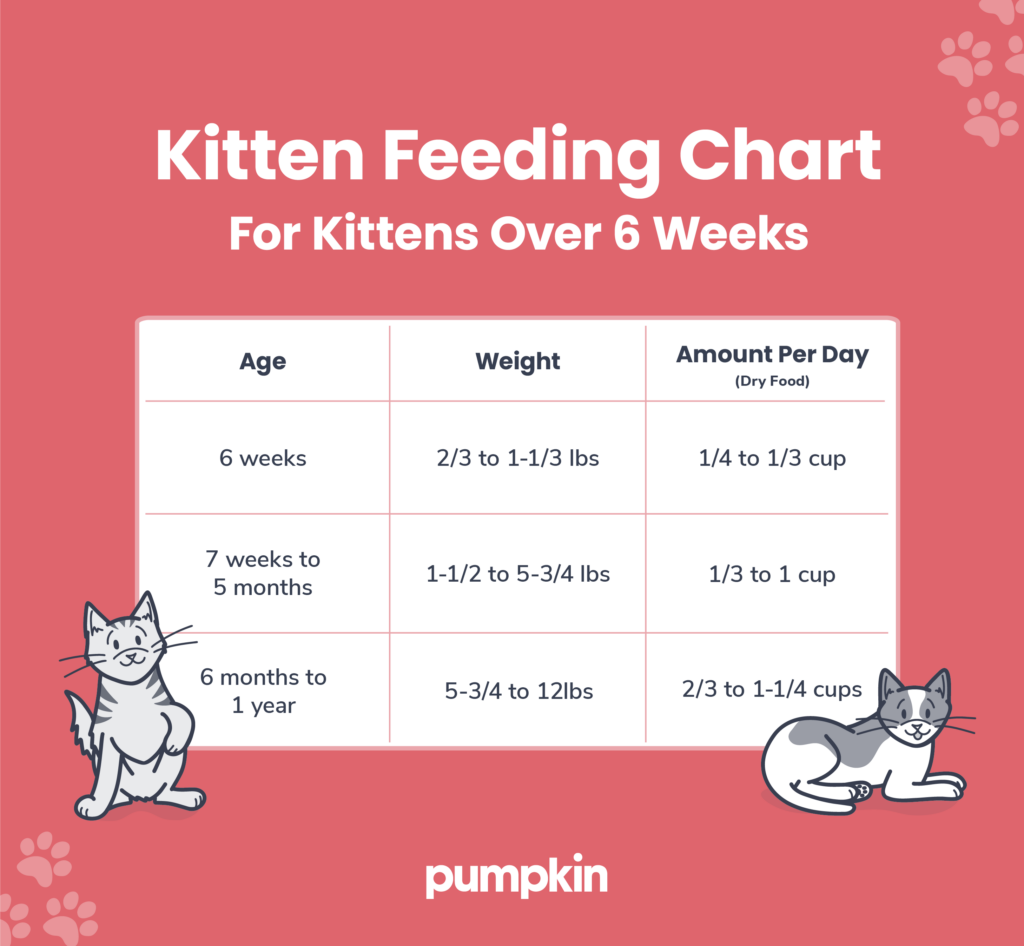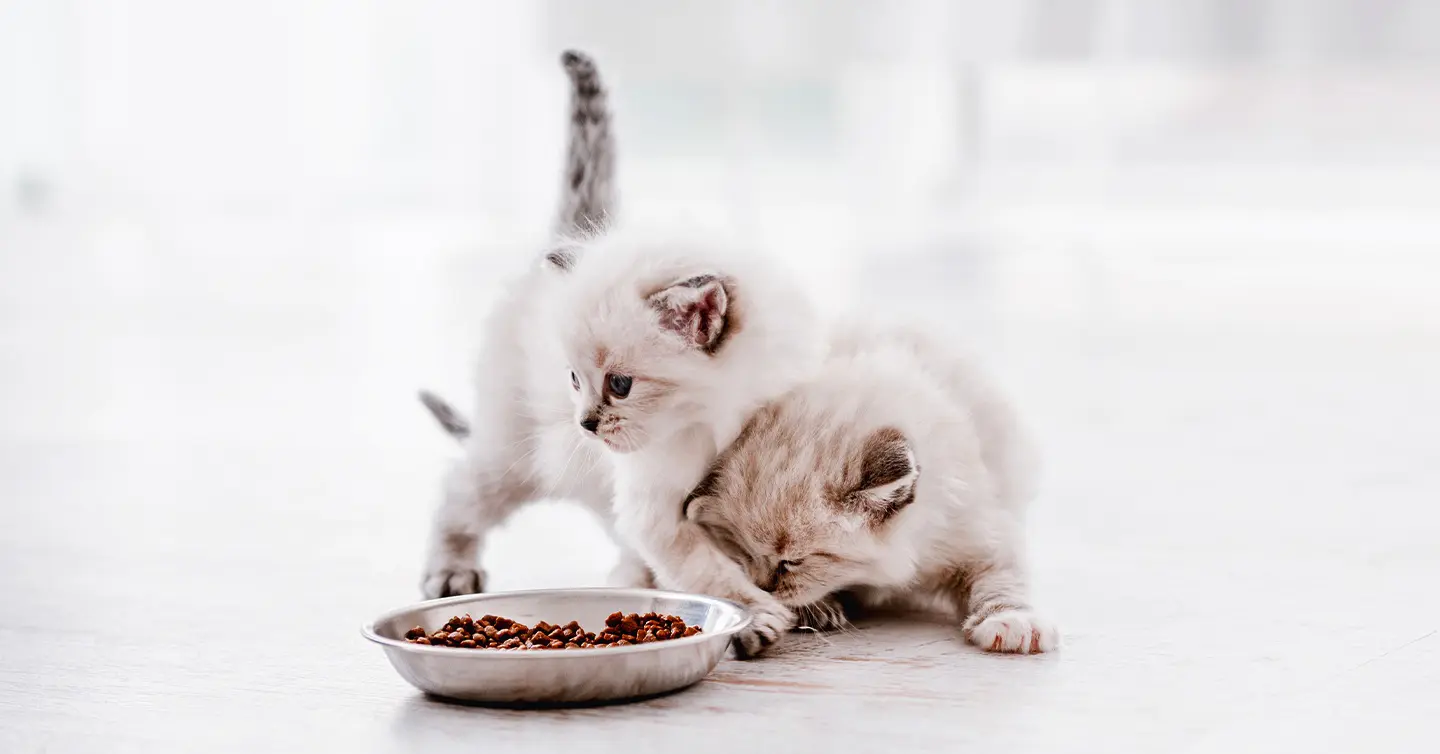Key Points
- How much a kitten should eat varies based on age, weight, and other nutritional needs.
- Most kittens under six weeks old will drink 2-22 ml of formula or cat milk per day.
- Most kittens over six weeks old should eat ¼ to 1 and ¾ cups of dry food per day.
- When in doubt, always consult your vet about your kitten’s unique dietary needs.
If you’ve recently welcomed a new kitten into your family, you may be wondering how much their little body needs to eat.
Feeding kittens the correct amount and type of food is essential to their health and well-being – but how much your pawfect pet needs will depend on their weight, age, and more.
Remember that every kitten has their own unique needs, so when in doubt, be sure to ask your vet for advice. In the meantime, read on for our kitten feeding charts and a few additional meal-time tips!
Feeding chart for kittens under six weeks old
Young kittens need to be regularly fed a lot of nutrients in their first weeks of life in order to thrive. Most kittens get their nutrition from their mothers’ milk until they are around six weeks old. However, if you meet a newborn kitten whose mother cat is unable to feed them, the kitten will need to be bottle-fed with a kitten milk replacement.
Once you find a formula that your kitten is happy with, you should generally feed your kitten until their belly is full, every couple of hours. The chart below shows recommended feeding guidelines for most kitten formulas. For more specific guidelines, ask your vet which kitten formula they recommend.
| Age | 0-1 week | 1-2 weeks | 2-3 weeks | 3-4 weeks | 4-5 weeks | 5-6 weeks |
| Amount | 2-6 ml | 6-10 ml | 10-14 ml | 14-18 ml | 18-22 ml | Switch to food |
| Timing | Every 2 hours | Every 2-3 hours | Every 3-4 hours | Every 4-5 hours | Every 5-6 hours | Every 6 hours |
Weaning from formula to kitten food
At four or five weeks of age, mother cats start to wean kittens off of their milk, so they should begin to transition to kitten food. Bottle-fed kittens should also be introduced to kitten food at this same time. This can be done by mixing bits of kitten food with kitten formula. You’ll still want to still supplement with kitten formula to make sure they’re getting enough nutrients, but consult your vet to get their take on it as well.
At five weeks of age, you can introduce your kitten to dry kitten food along with a bowl of water. Gradually decrease any formula use until your kitten fully transitions to solid kitten food.
At eight weeks of age, your kitten should be drinking water and eating completely on their own. Make sure to consult your vet if your kitty is having trouble with this adjustment.
Feeding chart for kittens over six weeks old
Once your kitten is eating solid food, it’s important to start them on a healthy eating schedule as soon as possible. But what does that look like for your kitty?
Kitten feeding amounts vary not only by the age and weight of your kitten but also by what type of food you’re feeding them. According to Dr. Jamie Whittenburg, Cat World veterinarian and director of Kingsgate Animal Hospital, no two foods are the same. “Some have many more kcals per cup than others, so it is not possible to say what amount should be fed to a kitten without calculating kcals per cup,” she explains.
Dr. Whittenburg also recommends offering wet, moist, or otherwise canned food to kittens between the ages of six and twelve weeks. “It is advisable to acquaint kittens with wet and dry food when they are young so they will readily accept both throughout their lives,” she says.
Below is a general kitten feeding chart, much like what you’ll find on most kitten food labels. Make sure to check the back of food packaging for more specific dietary information.

After one year, ask your veterinarian about switching your kitten to adult cat food.
How many meals should a cat eat in a day?
“Kittens are individuals with different personalities and metabolic needs,” says Dr. Whittenburg. “Some kittens will graze on small amounts of food throughout the day, while others prefer eating fewer but larger meals.”
Kittens eat between three and six small meals throughout the day, and as adults, they need to have at least two meals per day. That’s why it helps to leave out food – but if your kitten is a quick eater, you’ll want to space out their eating times accordingly.
Feeding schedule
| Age | Weight | Amount per day (dry food) |
| 6 weeks | 2/3 to 1-1/3 lbs | 1/4 to 1/3 cup |
| 7 weeks to 5 months | 1-1/2 to 5-¾ lbs | 1/3 to 1 cup |
| 6 months to 1 year | 5-3/4 to 12 lbs | 2/3 to 1-¼ cups |
Kittens require more meals than adult cats since they’re growing! They’re also very active, so spacing out meal times can help them maintain healthy energy levels. The earlier you get your kitty into an eating routine the better – which is why we’ve created a sample schedule below.
Sample kitten feeding schedule
- Breakfast of champs: As soon as you wake up (or as soon as your very active fur baby wakes you up), feed your kitten a third of their required amount of food per day. This can be wet or dry food – but if it’s wet food, take away the food bowl after 15 minutes or so. Wet kitten food cannot sit outside of a refrigerator for too long. However, it can help hungry kittens if you leave out a little bit of dry food throughout the day and night. Wash their water bowl too, and fill it up with fresh water.
- Post-breakfast potty break: This is a great time to introduce a new kitten to their litter box! Most kittens are quick to understand where to go to the potty, but make sure to ask your vet if your new pal needs litter training tips.
- Lunch time: If it’s been three hours, it’s probably time to feed your kitten again! Before and after lunchtime, don’t be surprised if you find your kitten running around the house wanting to play or sleeping a lot. Kittens are active, and they need rest and food to help them grow!
- Dinner: It’s dinner time! Give your kitty another third of their required amount of daily food, and leave out a bit of dry food before you sleep. The sooner you establish a before-bedtime routine, the sooner your kitten will understand their humans want quiet time at night.
If feeding your cat multiple times per day is challenging for your schedule, Dr. Whittenburg suggests free feeding, or leaving dry food out, as a potential solution. “The beauty of free feeding young kittens is that there is rarely concern about whether or not the kitten is getting enough food,” she explains. “All that must be done is to ensure they have adequate access to the food and that it is appropriate, nutritionally balanced kitten food.”
Dr. Whittenburg also advises that canned food be offered twice per day to ease kittens into a “meal-fed” habit. “I recommend switching them to twice daily feeding at around six months,” she says.
It’s not just about quantity, it’s also about quality
Feeding your kitten the right portions doesn’t help their nutrition if you’re not feeding them high-quality food. So don’t pick just any bag of kibble! Research the ingredients and also consider asking your vet for tips. Your kitten’s diet can contribute a lot to their growth, energy levels, and overall quality of life.
We especially recommend kitten foods that are made with animal-based protein sources, along with fish oils that contain omega fatty acids that are healthy for kittens. We also recommend cat food that is free of artificial colors, preservatives, and flavoring.
Kitten food that is rich in moisture helps your kitty stay hydrated, so wet food is a particularly good option if your kitten is teething or disinterested in their water bowl. Many pet parents offer their cats a combination of wet food and dry food to vary their diets and keep mealtime interesting!
What about human food?
Before you feed your kitten some of your groceries, always be sure to do your research. Some human foods are great for cats – but without the portion recommendations that come with cat food, you’ll want to speak to a vet about recommended portions. Some human foods that kittens can eat include fish, meat, cheese, bananas, pumpkin, egg, and oatmeal.
If you’re giving treats to your cat, also be mindful that most cats are allergic to certain foods. Foods that are toxic to cats include chocolate, grapes, raisins, onions, garlic, and even some types of dog food. If you have another pet in the house, be sure to ask your vet whether your kitty is safe to graze on Fido’s food.
Should kittens take supplements?
Supplements are a great way to help improve your kitten’s overall health. Think of them as a daily vitamin! Supplements like fish oil can be necessary if your kitten has certain skin problems, obesity, or other dietary needs. This is a great question for your veterinarian who knows the specific needs of your kitten.
How much exercise does a kitten need in between meals?
In addition to feeding your growing kitten the appropriate amount of food, it’s important to keep them active. Kittens need between 30 minutes to two hours of exercise per day, so be sure to get lots of playtime in and invest in some toys to keep them stimulated. Cats are natural hunters, so toys and activities that simulate hunting are especially fun for them. This helps with the “zoomies” and also helps teach kitties not to “hunt” their parents’ arms!
How much you feed your kitten is an important part of ensuring they lead a happy, healthy life. When in doubt, talk to your veterinarian! They’ll be able to work with you on deciding the best plan for your sweet kitty’s dietary needs.
As a loving cat parent, we know you only want the best care for your whiskered friend. That’s why Pumpkin Kitten Insurance plans help cover up to 90% of eligible vet bills for kittens. No matter what hairballs life throws your way, your kitty deserves the best care pawsible.




